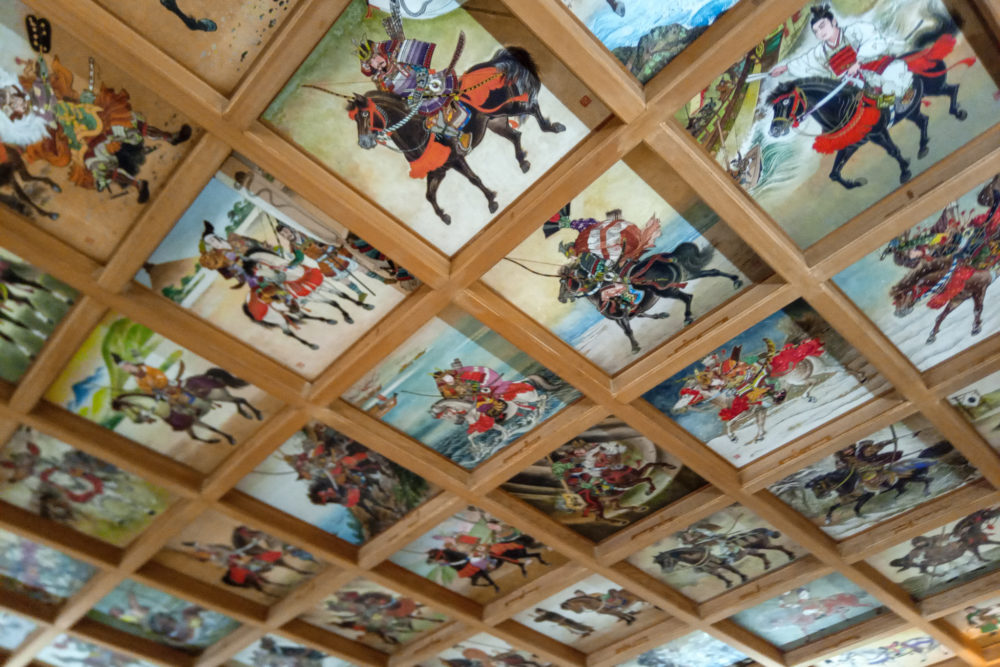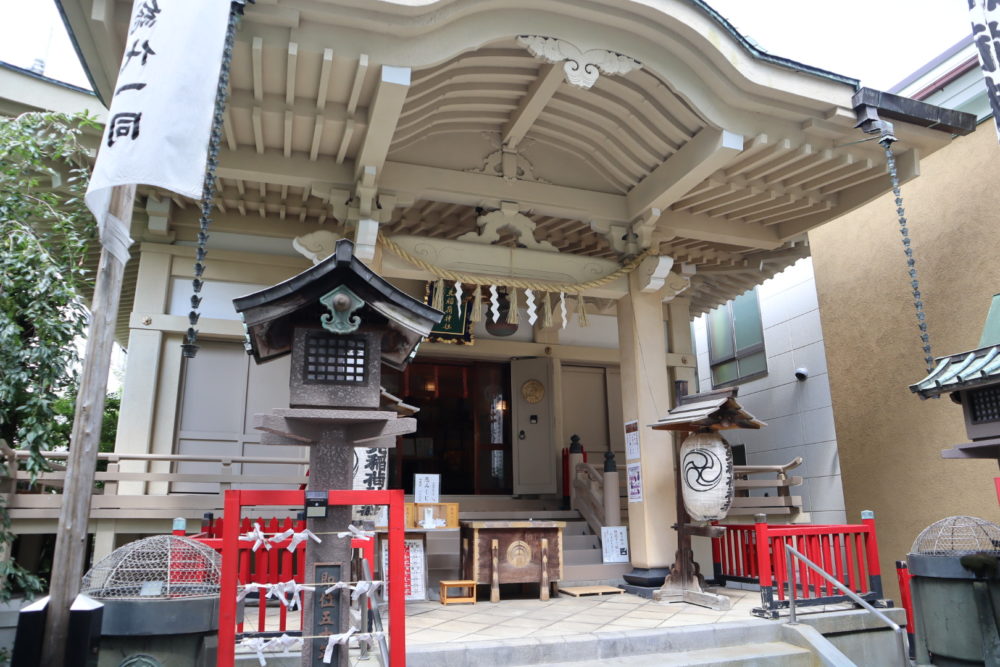This blog post will introduce Yasaki Inari Shrine (矢先稲荷神社) near Asakusa of Tokyo.
Yasaki Inari Shrine is a Shinto shrine in Taito Ward of Tokyo. It takes about 7 minutes from Tawaramachi Station on the Ginza Line. And Kappabashi Kitchenware Town is close by.
Yasaki Inari Shrine enshrines Inari (稲荷神), a Shinto goddess of agriculture. Her blessings include good harvests, business success, household safety, performance art improvement, etc.
The Tokugawa Shogunate built the Edo Sanjusangendo in the Asakusa area in the 17th century. And the Shogunate also built Yasaki Inari Shrine to guard the Edo Sanjusangendo.
On the ceiling of the worship hall at Yasaki Inari Shrine, you can see 100 paintings with a horse riding motif. These paintings depict 100 notable historical figures of Japan.
This blog post is also available in Plain Japanese and in Yasashii Nihongo (やさしい日本語). You can refer to them from the following links:
History
According to Yasaki Inari Shrine, its history dates to the 17th century.
In 1642, Tokugawa Iemitsu, the third Shogun of the Tokugawa Shogunate, built the Edo Sanjusangendo in the Asakusa area. This building imitated the Sanjusangendo in Kyoto. Tokugawa Iemitsu also built Yasaki Inari Shrine to guard the Edo Sanjusangendo.
In 1698, there was a major fire called the Chokugaku Kaji. The fire spread to what is now Chuo Ward, Chiyoda Ward, and Taito Ward of Tokyo. It also burnt the Edo Sanjusangendo and Yasaki Inari Shrine.
In 1701, Sanjusangendo was rebuilt in the Fukagawa area. On the other hand, the local people asked to rebuild Yasaki Inari Shrine in Asakusa.
Unfortunately, the Bombing of Tokyo destroyed the shrine in 1945. The current shrine was rebuilt in 1960.
Enshrined Gods and Their Blessings
Uka no Mitama no Mikoto (倉稲魂命)
- Other names: Inari no kami (稲荷神), Uka no mitama no kami (宇迦之御魂神), etc.
- Divinity: A Shinto goddess of grain, agriculture, etc.
- Blessings: Huge harvest, prosperous business, household safety, industrial prosperity, traffic safety, performing arts improvement, etc.
Fukurokuju (福禄寿)
- Other names: Fukurokujin (福禄人)
- Divinity: A god of happiness, ecomomic fortune, and longevity
- Blessings: descendants prosperity, economic fortune, good health, longevity, popularity, matchmaking, etc
Highlights
The 100 Paintings of the Japanese Horse Riding History

On the ceiling of the worship hall at Yasaki Inari Shrine, you can see 100 paintings with a horse riding motif. These paintings depict the Japanese Horse Riding History from Emperor Jinmu (神武天皇), the first emperor of Japan, to Takeichi Nishi (西竹一), a colonel during the World War II.
When the shrine built a new worship hall in 1960, the shrine and its worshippers requested Ebine Shundo (海老根駿堂), a Japanese painter, to draw these 100 paintings. Then the 100 paintings were dedicated to the shrine in 1964.
These paintings are open to the public; you can enjoy them for free. However, you will have to take off your shoes when you get into the worship hall. And barefoot is not allowed; you need to ware shocks or stockings.
Some people mention that the official guidebook of the Hollywood movie “The Last Samurai,” starring Tom Cruise, featured 10 of these paintings. However, we couldn’t confirm it as this guidebook is currently out of print.
The ceiling paintings are also available on the following websites. It could be a good idea to check before you visit Yasaki Inari Shrine.
The Seven Lucky Gods of Asakusa (Fukujushin)
Yasaki Inari Shrine enshrines Fukurokuju of the seven lucky gods, a Shinto god of happiness, property, and longevity. Therefore, you can expect economic fortune, good health, longevity, and other benefits by worshipping him.
Fukurokuju at Yasaki Inari Shrine is one of the Seven Lucky Gods of Asakusa. The Seven Lucky Gods of Asakusa refer to the seven lucky gods enshrined at nine Shinto shrines and Buddhist temples in Taito Ward and Arakawa Ward of Tokyo. Therefore, making a pilgrimage to these nine sites is one good example of enjoying the Asakusa area.
For more information about the Seven Lucky Gods of Asakusa, please refer to the following article:
Other Useful Information
Opening Hours
- Unknown
TEL
- 03-3844-0652
Address
- MAtsugaya 2-14-1, Taito-ku, Tokyo 111-0036
Google Map
Public Transport (Train)
- 7 minutes on foot from Tawaramachi Station on the Tokyo Metro Ginza Line
- 10 minutes on foot from Inaricho Station on the Tokyo Metro Ginza Line
- 11 minutes on foot from Asakusa Station on the Tsukuba Express Line
Please refer to the following blog post for the route from Taharamachi Station to Yasaki Inari Shrine.
Public Transport (Megurin Bus)
- 3 minutes on foot from #28 Matsugaya Stop on Megurin East-West Route (via Ueno Park)
- 3 minutes on foot from #28 Matsugaya Stop on Megurin East-West Route (via Uguisudani Station)
- 3 minutes on foot from #23 Matsugaya Stop on Megurin South Route
After you get off a Megurin bus, walk toward the East to view Tokyo Skytree for about 1 minute. Turn right at the corner when you arrive at a butcher shop named Niku no Marutake (肉のマルタケ). It takes about 2 minutes to get to Yasaki Inari Shrine from there.
Megurin Bus is a community bus service operated by Taito Ward of Tokyo. This bus is a good option for trying a non-touristic experience while you are in Tokyo. For more details on Megurin Bus, please refer to the following:
Public Transport (Bus)
- 3 minutes on foot from Kikuyabashi Bus Stop on the Toei Bus Route 上 23
- 3 minutes on foot from Kikuyabashi Bus Stop on the Toei Bus Route 上 46
- 3 minutes on foot from Kikuyabashi Bus Stop on the Toei Bus Route 草 39
- 3 minutes on foot from Kikuyabashi Bus Stop on the Toei Bus Route S-08
When you get off a bus at Kikuyabashi Stop, you will see Yawataya Chaho (八幡屋茶舗) and Yoshida Hoiten (吉田法衣店) in front of you. Walk the street between those shops. It takes about 3 minutes to get to Yasaki Inari Shrine.
Public Restroom Availability
- No. You will have to use one at a convenience store near the shrine.





